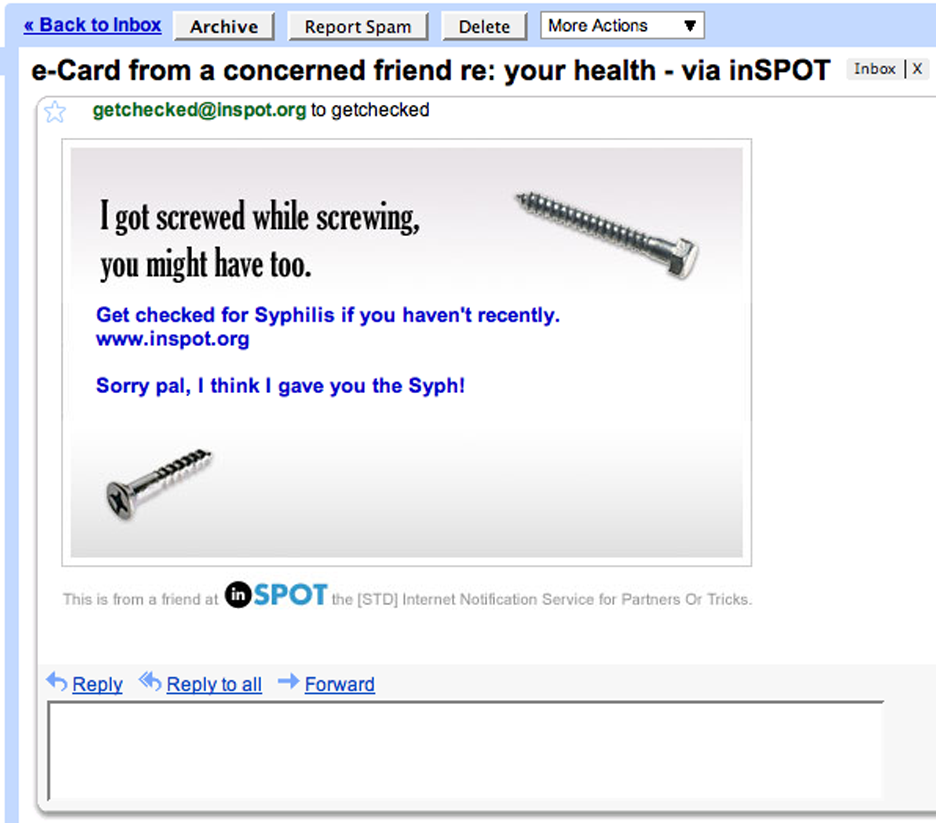If You’re Reading this E-card, I’ve Got Some Bad News
“STD E-Cards” Provide a New Way to Tell Your Lovers They May Have Gotten More Than an Orgasm
June 5, 2011

Published: November 20, 2008
So imagine me sitting at home, basking in the success of midterms and pondering my own brilliance when I hear the ping of my e-mail alerting me to a new message. I notice that I’ve been sent an electronic card (e-card). I smile smugly—probably a congratulatory note from a classmate I’d inspired, ‘cause I’m inspiring.
I open the e-card, eager for the accolades, when I read: “I got screwed while screwing, you might have too. Get checked for STDs. xoxo, Joe.”
Sound of needle scratching over the record.
Okay, so that didn’t happen, but let’s face it, given the prevalence of STDs, my low tolerance for alcohol and generally dubious judgment, this scenario is all too likely. But an e-card?
As a medium of communication, you really can’t beat the ease and expeditious nature of an e-card. In 2004, the San Francisco Department of Public Health, together with Internet Sexuality Information Services (ISIS), a non-profit organization focused on high-tech solutions for sexual health education, sought to take advantage of this medium to more effectively address partner notification of STDs.
The result was InSpot, a Web site that allows users to anonymously generate e-cards to communicate potential STD exposure to sexual partners. For college students, the appeal may be threefold: InSpot uses technology the Facebook generation is already familiar with, it can be anonymous and lastly, it alerts your partner to his or her STD status in a non-confrontational way.
Users indicated that the latter was the key reason they would use InSpot e-cards, according to ISIS.
InSpot’s design is simple. The site has two steps: Tell Them and Get Tested.
In the Tell Them section, users choose one of six e-cards, type in the recipient’s e-mail address, select the STD from a pull-down menu and either type in their e-mail and personal message or send the e-card anonymously.
The Get Checked section provides recipients with information about their particular STD and a map of local testing centers and links to online resources.
In the past, partner notification depended on phone calls, snail mail or in-person conversations. Because disclosure relies on the participation of the STD-infected individual, in a large city like New York, with high populations of infectees, notification can mean the difference between a few incidences of infection and an all-out epidemic, according to ISIS.
“For those who tend to have higher numbers of partners, online notification may be an effective strategy to increase partner notification,” said Jennifer M. Mulvey, coordinator of health services.
Many students also seem receptive to the innovation. “I think it’s a great idea,” said Chris Schneller, FCLC ’10. “People live their lives online and express themselves online, and they’ll be more confident [about disclosure] because they don’t have to deal with confrontation.” In addition, sexually active students may take STDs more seriously.
“I remember telling this one person I had strep throat and they were like, ‘I don’t care, kiss me!’ I mean it’s not an STD, but still,” Schneller added.
Despite their numerous benefits, some view STD e-cards as impersonal and somewhat offensive.
“When it comes to that particular issue, I can see the appeal because there is less chance of getting slapped. But I’d never do it that way, and I’d be very offended if it ever happened to me,” said Sam Lopresti, FCLC ’11.
However, in order to interrupt patterns of infection, early partner notification is necessary, according to ISIS.
Over the last 30 years, new diseases such as HIV/AIDS have emerged as subjects of great concern for public health. In addition, leaps in our ability to connect with multiple partners through chat rooms and social networking sites have contributed to the urgency of early intervention and notification.
What hasn’t changed is the psychological barrier that some people may need to overcome in order to notify their partners. ISIS’s innovative approach provides an effective and anonymous method to quickly communicate a possible transmission.
“The technology speaks to our current lifestyle choices, different than 50 years ago. But the elevating goal is to provide a forum for people to communicate with their partners because they want them to be protected,” said Elizabeth Norberg, FCLS ’09.
Since its launch, ISIS has reported that more than 30,000 people have sent 49,500 e-cards. Despite this usage information, ISIS does not have any data on the number of users who ultimately seek STD testing after notification.
ISIS cautions that InSpot is not intended to serve as a replacement for more traditional disclosure methods.
“The traditional way of partner notification done in person or by phone is still ideal,” Mulvey said.
This may be a relief for some young people who fear that the impersonal nature of STD e-cards says something about our generation.
“I think this is absolutely rude and impersonal, [but] maybe it is just the way our generation has become so dependent on technology and we turn to it for all our answers,” said BetaMia Coronel, FCLC ’09.








